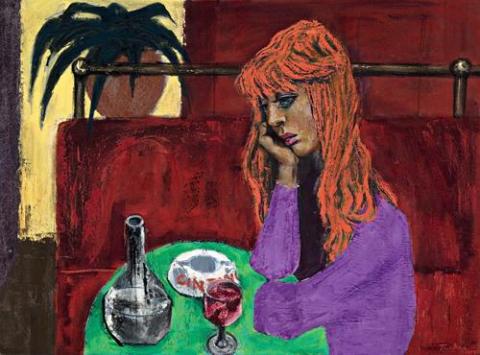AUSTRALIAN GIRL IN PARIS, 1957
Albert Tucker
synthetic polymer paint on composition board
96.0 X 130.0 cm
signed and dated lower right: Tucker/ 1957 inscribed verso: AUSTRALIAN GIRL IN PARIS/ ALBERT TUCKER/ c/o The Bank of New South Wales/ 47 Berkeley Square/ London W.1/ England
Christie's, Sydney, 22 October 1975, lot 496 as 'Australian Girl in Paris, No.2'
Private collection, New South Wales
Australian Girl in Paris 2, 1957, synthetic polymer paint on composition board 97.0 x 131.0 cm, National Gallery of Victoria, Melbourne (on loan from Barbara Tucker)
Artists, like everyone, tend to get type cast. Tom Roberts is remembered for shearing the rams, and Sidney Nolan is almost the alter ego of Ned Kelly. For Albert Tucker there are the Images of Modern Evil and the profiled gothic heads of Australian explorers. They are so powerful that one tends to forget that Tucker was also a gifted painter of portraits. The roll call is long- numerous self-portraits in the best Australian galleries, images of the Boyds, Joy Hester, Sidney and Cynthia Nolan, Bernard Smith, and the Reeds. The identity of Australian Girl in Paris, of which there are two versions, is not known; but the strikingly individual features and portrayal of character indicate that she was a person known to Tucker. The aquiline face dominated by big blue eyes and sensuous red lips, topped by flaming red hair make a face not easily forgotten.
The late fifties were important for Tucker. He was represented in the 1956 Venice Biennale; held a solo show at the Imperial Institute, London the following year; and Lunar Landscape was purchased by New York's Museum of Modern Art- incredibly, Tucker's first work to enter a public art gallery. In 1957, Australian Girl in Paris was included in The Australian Women's Weekly Portrait Prize, Tucker's Australian Gothic winning the 'best subject painting' the next year. Earlier contact with Nolan in Rome inspired thoughts of Australia. When he returned to London, where Australian Girl in Paris was painted, nostalgia was in the air. London was cold and reserved. He loved Paris, as Janine Burke wrote: 'Tucker was captivated by a city traditionally associated with art, bohemianism and romance; an exquisitely feminine and beautiful place, sophisticated, sensuous and stimulating.'1 In Australian Girl in Paris, the feminine beauty of the Parisian is identified with the Australian, seated in a bistro, glass of red wine untouched. Reflective and forlorn, dreaming of Australia, which for artist and model was far away. The green tabletop suggests France, surrounded by the desert reds of Australia. The companion painting, the scene outside the Metro, is a metaphor of travel, ever on the mind of the expatriate.
Tucker's model was the flamboyant Vali Myers, an Australian artist and dancer, known for her bohemian lifestyle, flaming red hair and, later, tattoos. At nineteen, she went to Paris, her Left Bank encounters including Jean Cocteau, Tennesse Williams, Salvador Dali and Albert Tucker.
We are grateful to Janine Burke for identifying the model.
1. Burke, J., Australian Gothic: A Life of Albert Tucker, Knopf, Random House, Australia Pty Ltd, Sydney, 2002, p.302
DAVID THOMAS
